

Five police forces are involved in policing the River Thames with The Marine Support Unit of the Metropolitan Police (formerly known as Thames Division), having the responsibility of policing the 40 miles of the River Thames between Dartford Creek and Hampton Court.

The 14 miles of the River between Hampton Court and Bell Weir is policed by Surrey Police who have a dedicated officer based at Shepperton but they do not patrol afloat. The Environment Agency (EA) provides a launch whenever the need arises.

Above Bell Weir the River is policed by Thames Valley Police but this force does not have a dedicated river section although it did, until a few years ago, have its own police launch, 'Sit Pax', but this was decommissioned in 1998.
The River below Dartford comes under the jurisdiction of the Kent and Essex Forces but only Essex has a dedicated river section.
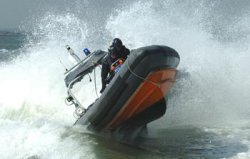 |
One of the Current Boats in the Marine Unit Fleet |

The Essex Police Marine Unit was formed in 1949 when it purchased an ex-RAF seaplane tender and named Vigilant. The River Section, as it was called then, comprised this vessel, a sergeant and four constables. In 1959 Vigilant was replaced by a 42 foot launch and named Vigilant II and in 1967 a 22 foot cabin cruiser Alert, joined the 'fleet' and was crewed by a sergeant and a constable. In 1971 a further vessel, The Watchful, was acquired and the section was increased by another sergeant and two constables. An inspector was appointed to oversee the enlarged unit which was renamed the Marine Section. These vessels were replaced byVigilant III and Alert III. However, today only Vigilant III remains in service but she is supported by a fleet of smaller and faster craft. The Unit is about to take delivery of the first of two high speed Halmatic Artic 24 Rigid Hulled Inflatable Boats with twin 200 BHP engines to replace two of its existing fleet. The Marine Unit is based at Burnham-on-Crouch police station and now consists of one Sergeant, eight Constables, two Special Constables and one civilian Marine Engineer. The Marine unit polices the River Thames (from the Metropolitan police boundary at Dartford Creek), the rivers Blackwater, Colne, Stour and Crouch and the Essex coastline up to Harwich. The main priority of the Unit is the maintenance of law and order and it works closely with immigration officials and Customs & Excise.
The Marine Support Unit of the Metropolitan Police is the oldest police force in the country. It was formed in 1798 by Patrick Colquhoun, a magistrate and John Harriot, a master mariner, to combat theft, looting and corruption in the Port of London which were rife at that time. It was known as The Marine Police Force and its annual cost of £5000 was shared between the Exchequer (£980) and the West India Merchants and Planters Company (£4020).
They took a lease of premises on the current site of Wapping Police Station and appointed a Superintendent of Ship Constables with 5 Surveyors to patrol the River, day and night. These Surveyors were rowed in open Galleys by Police Watermen. They also had 4 Surveyors visiting ships being loaded and unloaded, with Ship Constables (who were appointed and controlled by the Marine Police Force but paid for by ship owners and not out of police funds) supervising gangs of dockers. A Surveyor of Quays with 2 assistants and 30 Police Quay Guards watched over cargos on shore.
31 years later in 1829, Robert Peel formed the Metropolitan police Force by which time The Marine Police had 3 police stations (Wapping, Waterloo and Blackwall) and 15 boats. Ten years later in 1839, the two Police Forces amalgamated with the Marine Police force becoming Thames Division, a name it kept until 2001.
In these early days, the police carried out their duties in rowing boats (which were still in use until 1925) but two steam launches were introduced in the mid 1880's. By 1898, it had a further 8 steam launches to supplement its 28 rowing galleys. In 1910 the first motor boats were introduced.
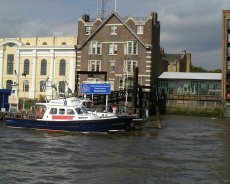 |
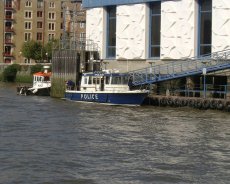 |
Wapping Police Station |
A Fast Response Boat |
Today, Thames Division, which was renamed the Marine Support Unit (MSU) in 2001, is part of an Operational Command Unit (OCU) called Specialist Support and is commanded by a Chief Inspector. It has 89 police officers supported by 8 civilian staff and 8 specially qualified Special Constables. The fleet comprises four Targa 31ft fast response boats, one Targa 37ft logistical support vessel and five rigid inflatable boats ( for counter-terrorist use). Three semi-displacement patrol boats are used for training, diving and other support uses. Eight Zodiac inflatable dinghies provide cover for flooding contigencies and one Del Quay Dory is used for Dockland Security. The Fleet also has a command vessel (the 'Patrick Colquhoun'). It operates out of its HQ at Wapping River Police station, about a mile downstream from Tower Bridge, the third police station on this site since the first marine police station was opened in 1798. There are currently four reliefs (24 hour response teams) each with two sergeants and 12 constables. They operate 24 hours a day, 365 days a year with at least one boat actually patrolling the river at night.
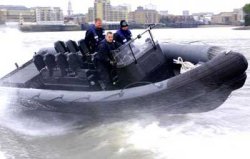 |
On Patrol in a Rigid Inflatable Boat |
Each patrol boat is manned by a sergeant (or sometimes an inspector) and two constables and are all volunteers who have served at least two years as 'ordinary' land police officers. On joining the Marine Support Unit, an officer undertakes a one year probationary period. During this period the officer undergoes a total of eight weeks formal training of which Rearch and Rescue techniques form part.
In the early days, the main duties of the police was the prevention of looting and pilfering from cargoes in the docks. Today, the primary role of the River Police is to fight crime, prevent disorder and provide a visible deterrent against drug importation and terrorism. The MSU works closely with the Port of London Authority, the London Coastguard, the RNLI, the London Fire Brigade and the Port Health Authority. Together all these agencies comprise the Thames Counter-Terrorist Partnership.
Despite the fact that the Marine Support Unit is not a statutory SAR (Search and Rescue) organisation, the recent growth in leisure activities on the Thames has added to their tasks as they spend more time assisting people sailing their own boats and advising the public about basic safety rules and regulations to avert possible accidents.
One of their most distressing jobs, however, is recovering bodies from the River. On average over 50 people lose their lives in the Thames each year and about 80% of these are by suicide (usually by jumping off one of the many bridges that cross the Thames). After a body is recovered from the River it is taken to the mortuary at Wapping Police Station for identification.
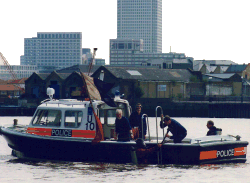 |
Divers Down |
The police frogmen or, to give them their proper name, the Underwater and Confined Space Search Team (UCSST), are also part of the Marine Support Unit and based at Wapping. But they donít just cover the River Thames; they also carry out searches in canals, ponds, lakes and reservoirs. It was set up as a full time unit in 1964.
In addition to the USSCT, the Marine Support Unit has two further teams: The Marine Intelligence Team and the Terrorism and Crime Team. The Marine Intelligence team are responsible for gathering all intelligence and information relating to marine crime and criminals using the water. It is the only unit of its kind in the UK and it liases with other police forces around the country. The Terrorism and Crime Team carries out additional tasks to those of the 24 hour response teams and target crime hotspots not only on the Thames but on other canals and inland waterways in and around London.
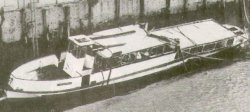 |
The 'Marchioness' the Following |
At about 1.50am on 20 August 1989, when the aggregate dredger 'Bowbelle' collided with the Passenger vessel 'Marchioness' just upstream of Cannon Street Railway Bridge, four police patrol boats were on the scene within six minutes and with the assistance of another passenger launch, the 'Hurlingham', which was in the immediate vicinity, rescued 87 people from the River that night. In the days that followed, police officers from the Marine Support Unit, working 12 hour shifts, recovered 51 bodies, 24 from the wreck and 27 from the River.
The Marine Accident Investigation Branch of the Department of Transport carried out an investigation into the 'Marchioness' accident and in June 1990 issued its report containing 27 safety recommendations, all of which have been implemented.In December 1991, the then Secretary of State for Transport, Malcolm Rifkind MP, asked Mr John Hayes, Secretary General of the Law Society, to conduct an independent investigation into the handling by the Department of Transport of its responsibility for the safety of vessels on rivers and inland waters. His 'Report of the Enquiry into River Safety', containing some 22 recommendations, was presented to Parliament in July 1992.
Despite these reports and recommendations, safety on the Thames, especially on the tidal section, has remained a matter for concern.
Consequently, in August 1999 the Deputy Prime Minister, Mr John Prescott MP, announced that he had asked Lord Justice Clarke to conduct the 'Thames Safety Inquiry' to review and examine River safety and to advise whether there is a case for further investigation or inquiry into the circumstances surrounding the 'Marchioness' disaster. An interim report covering Part One of the Inquiry (relating to River Safety) and containing some 45 recommendations, was presented to Parliament on 2 December 1999 by Shipping Minister Keith Hill MP, who said "We welcome, and will act upon,[the judge's] recommendations for further action to improve safety on the River".
In response to this Inquiry into River Safety, the government asked the Maritime and Coastguard Agency (MCA), the Port of London Authority (PLA) and the Royal National Lifeboat Institution (RNLI) to work together to set up a dedicated Search and Rescue service for the tidal River Thames.
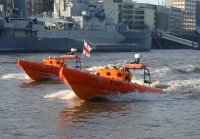 |
'E'class Tiger Marine Fast Response Craft |
Consequently, with effect from 2 January 2002, the RNLI set up four lifeboat stations: Gravesend, Tower Pier, Chiswick Pier and Teddington. The first three stations are permanantly manned to provide an immediate response to emergencies whilst the fourth station at Teddington, is manned by volunteers in the same way as other RNLI stations around our coast. The three full time lifeboats are capable of launching within one minute of being alerted and are able to reach any point on the River between Canvey Island and Teddington within 15 minutes. These lifeboat stations are manned 24 hours a day, 365 days a year with two of the three-person crew at each station being full-time with the third being a volunteer. The boats being used at these stations are 'E' class Tiger Marine fast response craft fitted with waterjet engines and capable of speeds up to 40 knots. They have aluminium alloy hulls with closed cell foam collars. The advantage of waterjets is that they do not have propellers that could become damaged by floating debris.
A standard RNLI 'D' class inshore boat is being used at Teddington. For further details about the launch of this service on the Thames in January 2002, Click Here
The lifeboats were called out about 850 times during their first year of service in 2002 and about 750 times in 2003.
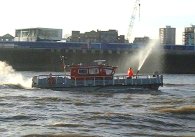 |
Fireboat |
The MCA (London Coastguard) will co-ordinate any rescue operation from a new centre at the Thames Barrier and the existing resources of the Marine Support Unit, the Fire Service and the PLA will continue to be utilised in emergency situations.
The 'Marchioness' disaster was the worst disaster on the Thames since 1878 when, at 7.35pm on the 3 September, the iron ship 'Bywell Castle' ran into the pleasure steamer 'Princess Alice' in Gallions Reach, upstream of Barking Creek. The paddle steamer was returning from the coast via Sheerness and Gravesend with nearly 800 day-trippers on board. She broke in two and sank immediately with the loss of over 600 lives. At the subsequent inquest and Inquiry, officials recommended that Thames Division should have steam launches as rowing galleys were inadequate for Police duty. As mentioned above the first two were commissioned in the mid 1880's.
To return to The River Thames page Click Here
Copyright © The Harts